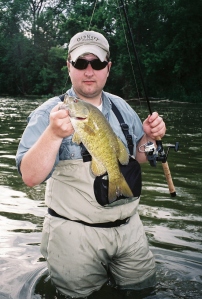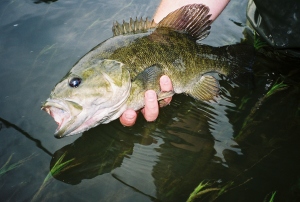 First off I want to thank everyone for their thoughts on this topic. I got e-mails from people all over the country on this topic. Some people agreed with my statement and my opinion on this topic, and some do not. Researching this whole topic has been a great learning experience and has furthered my knowledge even more on this topic. The answer to all this is in the middle, it’s impossible to make everyone happy when it comes to fish size and amount. Just like other things in life you can’t make everyone happy.
First off I want to thank everyone for their thoughts on this topic. I got e-mails from people all over the country on this topic. Some people agreed with my statement and my opinion on this topic, and some do not. Researching this whole topic has been a great learning experience and has furthered my knowledge even more on this topic. The answer to all this is in the middle, it’s impossible to make everyone happy when it comes to fish size and amount. Just like other things in life you can’t make everyone happy.
But what we can do as a group is better understand the management processes in our fisheries. Part one touched on the basic idea of how bodies of water become stunted and it all boils down to a few things. Biomass, Genetics, Forage, Habitat and Harvest. When all things are in balance, we can have just fantastic fisheries. But if one of these things gets out of whack to far we can have major problems. Most commonly stunted fisheries happen with our panfish, such has sunfish, crappies and perch. There has been some cases of stunting with northern pike, and bass. Those cases that I am aware of had a few other environmental issues that also aided in causing the problem.
So how do our DNR’s manage our waters? What are some of the tools they use to fix and prevent this from happening?

Photo by the Ohio DNR
One of the management tools used is by restricting and controlling what size of largemouth bass that’s harvested. A good example of this is Lake La Su Ann Wildlife Area in Montpelier, OH. It is a short drive across the border from Camden, Michigan. Lake La Su An Wildlife Area covers 2,430 acres and has 13 lakes and many small marshy areas. What they have done is manage the largemouth population so that they have a large population. They have done this with larger size limits so that it protects bass in the 12 to 17-inch size class. Bass at this size feed heavily and do a great job at keeping YOY (Young of the Year ) and lower year class panfish population in check. This management plan has given them a bass densities that are the highest in Ohio and the Midwest. It has kept the bluegills in check so well that on some lakes 40% of the bluegill harvest is of fish in the 8 to 11 inches range.
Another management tool is nutrient management. What this is , is where they come in and fertilize a lake that might be lacking in some nutrients. They generally will use a nitrogen based fertilizer to spark and boost the base of the food chain; plankton. What this does is help provide more food so that the fish can get what they need at key stages. This practice has been used in the UP of Michigan. The lake had a really bad stunting issue. The perch in the lake would only reach 4 inches in size no matter the age. This project was led by Lake State University in the 1990’s. That lake has since become a better fishery.

photo by Wisconsin DNR
Vegetation control is something else that’s used and not many people think of. The idea with this is to limit the amount of hiding places for the panfish. So that it’s easier for predators like largemouth and pike to feed. Lakes where the vegetation level is at or above 75% coverage are prime candidates for this. These lakes are fairly shallow most of the time They also have a very high amount of nutrients that promote rapid aquatic plant growth. Sometimes this is a man-made problem due to run off from farmlands and home lawn runoff. To fix this problem filter strips need to placed leading into these waterways to slow the rate and dilute the amount of nutrients being brought into the system. A program like the CREP here in Michigan is doing just that.
Some other things managers may do in extreme cases is to lower the water and remove fish, or they may kill off the lake. This is very expensive to do and is not done often. Once that’s done the lakes restocked over time. It can take up to 5 years before the lake will begin to have keeper size fish come out of it. One draw back to this though is that the bio-diversity becomes limited. These lakes will general have only a few species of forage base minnow, large sunfish species, bass and catfish. The reason for this is that the cost in trying to raise and transplant all the different types of species into a lake is huge. This is a last-ditch thing that our mangers hope to never have to use.
The last and newest ,is what the state of Minnesota is doing.They are testing the idea of making trophy bluegill fisheries. They have a very restrictive bag and size limits(5 fish) placed on the lake that they feel hold all the puzzle pieces to make very large gills in the 1 lb class. So far it looks like they maybe on to something with this idea but the experiment and study period is not done yet so we have to wait and see.
 You can see many things need to stay in balance but it takes just one thing to send a system into a tail spin.It’s very common for a combination of these tools mentioned above to be used to correct this problem.
You can see many things need to stay in balance but it takes just one thing to send a system into a tail spin.It’s very common for a combination of these tools mentioned above to be used to correct this problem.
We as anglers need to become more cognitive of our daily impacts on our waters.A few ways we can do this is to be selective in what and how much we harvest, what we put on our lawns. I was once told to remember that we all live down stream.

Another good read Justin. I’d like to add also that many of the “Special regulations” lakes here in Minnesota are not working out. I have fished a few of them and have not seen much of a change, on the other hand, there are also a few of them that seem to be doing great. What I have a problem with here, is the lack of seeing that things are not working in some cases, and doing something different. Choosing more lakes would be great as well. We sit here in the land of 10,000 lakes and only a handful get good help. The lakes that can draw $$$$$$ tourst seem to get the primary funding. Example: I have fished many of these little local lakes that have a problems with stunted panfish and pike … these lakes have never changed. I’ve fished them for close to 35 years, 40 if you count my baby years. I feel these lakes were over harvested before the DNR could enforce laws to protect these lakes. To this day DNR officers are streched thin, and many people think they can pull bucket after bucket of 14″ crappies out of a lake and they’ll just magically keep growing like that. A never ending supply! Shame on them …. they are the ones ruining these lakes.
I think we have the same problem here in Michigan also with the under funded DNR. They can only do so much. I hoping that with these two blogs that maybe we can start changing peoples values when it comes to panfish. Everyone wants big ones, and they want limits at the same time. Something has to give. Wait until you see the show I just shot with Michigan Out of Doors. We got a 14 inch crappie and it went back into the lake and we didn’t even think twice about it.